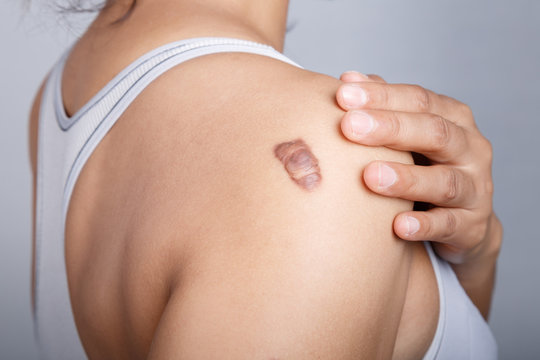Understanding Keloids: Causes, Symptoms, and Modern Treatments
What Are Keloids?
Keloids are thick, raised scars that extend beyond the original wound boundary. Unlike normal scars, keloids don’t stop growing once the wound has healed. They can form after surgery, trauma, acne, piercings, burns, or even minor skin injuries like insect bites. Keloids are benign (non-cancerous) but can be itchy, painful, and cosmetically distressing.
Why Do Keloids Form?
Keloids occur due to an overproduction of collagen during the healing process. While the exact cause isn’t fully understood, certain risk factors increase the likelihood:
- Genetics: A family history of keloids increases your risk.
- Skin type: Darker skin tones, especially people of African, Asian, or Hispanic descent, are more prone.
- Age: Most common between ages 10 and 30.
- Site of injury: Chest, shoulders, earlobes, and cheeks are common sites.
Symptoms of Keloids
- Raised, shiny, and smooth scar
- Pink, red, or darker than surrounding skin
- Itching or tenderness
- Continual growth beyond original injury site
How Are Keloids Different from Hypertrophic Scars?
While both are raised scars, hypertrophic scars stay within the boundary of the original wound and may regress over time. Keloids grow beyond the original wound and typically do not regress without treatment.
Treatment Options for Keloids
Managing keloids can be challenging, and no single treatment guarantees complete success. A combination of therapies often yields better results.
- Corticosteroid Injections
- How it works: Injected directly into the keloid to reduce inflammation and flatten the scar.
- Frequency: Usually every 3–4 weeks.
- Success rate: 50–80% improvement; however, recurrence is possible.
- Side effects: Thinning of skin, pigment changes.
- Silicone Sheets or Gels
- Use: Applied daily for several months.
- Action: Hydrates and compresses the scar, helping to flatten and fade it.
- Ideal for: Newer keloids and as post-treatment maintenance.
- Cryotherapy
- What it is: Freezing the keloid with liquid nitrogen.
- Effect: Destroys scar tissue and reduces size.
- Best for: Small, raised keloids.
- Side effect: Skin lightening (hypopigmentation), especially in darker skin types.
- Laser Therapy
- Types: Fractional Co2 laser is most commonly used.
- Effect: Reduces redness, flattens scar over time.
- Best when: Combined with other treatments like steroid injections.
- Surgical Removal
- Warning: High recurrence rate (up to 100%) if not combined with additional treatments to prevent recurrence:
- Post-surgery steroid injections
- Radiation therapy
- Silicone therapy
- Pressure Therapy
- Common for: Ear keloids after piercing.
- How: Compression earrings or bandages apply consistent pressure to prevent regrowth.
- Radiation Therapy
- Used after: Surgical removal to prevent recurrence.
- Effectiveness: Reduces recurrence when combined with other therapies.
- Caution: Long-term safety concerns, especially in younger individuals.
Are There Any New or Experimental Treatments?
Yes. Some newer treatments under study include:
- 5-fluorouracil (5-FU) injections: An anti-cancer drug that slows down cell growth in keloids.
- Botulinum toxin (Botox): May reduce scar tension and flatten keloids.
- Imiquimod cream: An immune response modifier sometimes used after excision.
Prevention Tips
- Avoid unnecessary skin trauma, especially in people prone to keloids.
- Use pressure earrings or silicone gel after piercings or surgeries.
- Seek early treatment for acne or injuries that could cause scarring.
Takeaway
Keloids can be persistent and frustrating, but modern dermatology offers several treatment options to manage and reduce their appearance. Since treatment results vary from person to person, a combination of therapies tailored by a dermatologist gives the best chance of success. Early intervention is key.
If you’re dealing with a keloid or skin prone to scarring, consult a dermatologist to explore the most effective strategy for your skin type.

